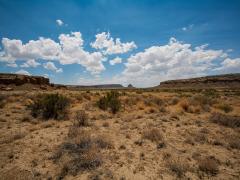Severe Drought Increases Mortality Risk in the Northern Rockies and Plains
Despite considerable public health concerns, drought assessments often disregard the health risks associated with drought exposure in the United States, particularly in regional-based assessments (Fard et al., 2022). One potential explanation of the lack of research is the complexity of linking drought to health outcomes. Drought lacks the direct pathway to health outcomes that many other climate-related events have.
To better understand the potential impacts of distinct drought patterns on human health, a new NIDIS-funded study, led by the University of Nebraska Medical Center and published in the Science of the Total Environment, examined the effects of monthly severe drought exposure on all-cause (deaths from any cause) and cardiovascular-related deaths in the Northern Rockies and Plains of the U.S. (including Montana, Wyoming, North Dakota, South Dakota, and Nebraska) from 2000–2018.
The study found that mortality associated with severe drought increased overall in this region, and several factors—including age groups, gender, and residing in an urban area—influenced the impact of drought on all-cause and cardiovascular mortality. These results can support public health managers to deliver early warning of the possible health risks of drought, and target their efforts to reach those most likely to experience drought-related illness.
Using three drought indices, the U.S. Drought Monitor (USDM), Standardized Precipitation–Evapotranspiration Index (SPEI), and the Evaporative Demand Drought Index (EDDI), the team found that during severe droughts, death due to all-cause and cardiovascular illness increased in the Northern Rockies and Plains. The length of modeled drought also impacted this risk. Mid-term (6-month) severe drought had a higher risk compared to a long-term (12-month) drought in the Northern Rockies and Plains.
Demographic factors also impacted results. The study considered the impact of drought by age group, race (white, black, and other than white and black), and sex. People who are elderly and white populations were found to be more vulnerable to the effects of severe drought exposure than people who are young and people of color. Both men and women were found to be vulnerable, and residents in both non-metro and metro counties showed a higher risk of all-cause and cardiovascular mortality.
Dust may explain the increase in death due to all-cause and cardiovascular illness. As soils dry out during a drought, dust and other particles are more likely to circulate in the air, affecting cardiovascular and respiratory diseases (Alpino et al., 2016; Bell et al., 2018; Bellizzi et al., 2020). Severe drought can accelerate this process, resulting in higher risks of such diseases.
Severe drought can increase risk of wildfires and dust storms, which contribute to worsening air quality. Poor air quality can both cause and exacerbate respiratory and cardiovascular disease, as fine particulate matter penetrates the lungs and bloodstream following inhalation (Ebi et al., 2021).
Geography is another potential explanation. According to the National Center for Health Statistics 2013 binary rural/urban categorization (Ingram and Franco, 2013), approximately 88.3% of the counties (257 out of 291 counties) in the Northern Rockies and Plains are rural. As agriculture and animal husbandry are the primary sources of income in this region, residents often spend more time outside and are expected to be more vulnerable to extreme climate events, such as drought.
Another explanation is a high population of elderly individuals in the area. Older residents may have pre-existing health concerns, a higher baseline death rate, comorbidity conditions, or poor access to medical service. Moreover, prolonged severe drought can cause increased stress, which can raise cortisol hormone levels and contribute to the development and worsening of cardiovascular disease (Whitworth et al., 2005).
Results of this study provide a valuable insight into the negative impact of drought on all-cause and cardiovascular health in different U.S. climate regions, which public health practitioners can use to deliver early warnings and targeted messaging to at-risk populations in the Northern Rockies and Plains.
Learn more about this research, or read the journal article.









